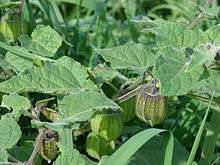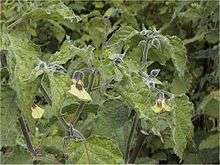Physalis
| Physalis | |
|---|---|
 | |
| cape gooseberry (Physalis peruviana) leaves and fruit | |
| Scientific classification | |
| Kingdom: | Plantae |
| (unranked): | Angiosperms |
| (unranked): | Eudicots |
| (unranked): | Asterids |
| Order: | Solanales |
| Family: | Solanaceae |
| Subfamily: | Solanoideae |
| Tribe: | Physaleae |
| Subtribe: | Physalinae |
| Genus: | Physalis L.[1] |
| Species | |
|
About 75-90, see text | |
| Synonyms | |
|
Alkekengi Mill. | |
Physalis (/ˈfaɪsəlɪs/, sometimes /faɪˈseɪlɪs/,[2] from physalis = bladder) is a genus of flowering plants in the nightshade family (Solanaceae), which grow in warm temperate and subtropical regions of the world. Most of the species, of which there may be 75-90, are indigenous to the New World. Cultivated species and weedy annuals have been introduced worldwide. A notable feature is the formation of a large papery husk derived from the calyx, which partly or fully encloses the fruit.[3] The fruit is small and orange, similar in size, shape and structure to a small tomato.
At least 46 species are endemic to the country of Mexico.[4]
Many Physalis species are called groundcherries.[5] One name for Physalis peruviana is Inca berry; another is Cape gooseberry, not to be confused with the true gooseberries, which are of the genus Ribes in the family Grossulariaceae. Other names used to refer to the fruit are poha berries, and simply golden berries.[6]
Description
Physalis are herbaceous plants growing to 0.4 to 3 m tall, similar to the common tomato, a plant of the same family, but usually with a stiffer, more upright stem. They can be either annual or perennial. Most require full sun and fairly warm to hot temperatures. Some species are sensitive to frost, but others, such as the Chinese lantern, P. alkekengi, tolerate severe cold when dormant in winter.
Cultivation and uses

These plants grow in most soil types and do very well in poor soils and in pots. They require moisture until fruiting. Plants are susceptible to many of the common tomato diseases and pests, and other pests such as aphids, whiteflies, spider mites, and the false potato beetle (Leptinotarsa juncta) also attack them. Propagation is by seed. Some species are self-incompatible and require pollen from other plants to bear fruit.
Not all Physalis species bear edible fruit. Select species are cultivated for their edible fruit, however; the typical Physalis fruit is similar to a firm tomato in texture, and like strawberries or pineapple in flavor, with a mild acidity. Some species, such as the Cape gooseberry and tomatillo have been bred into many cultivars with varying flavors, from tart to sweet to savory. Physalis fruit are rich in cryptoxanthin.The fruit can be used like the tomato. Once extracted from its husk, it can be eaten raw and used in salads. Some varieties are added to desserts, used as flavoring, made into fruit preserves, or dried and used like raisins. They contain pectin and can be used in pie filling.
The Cape gooseberry is native to the Americas, but is common in many subtropical areas. Its use in South Africa near the Cape of Good Hope inspired its common name. Other species of commercial importance include the tomatillo (P. philadelphica). Some nations, such as Colombia, have a significant economic trade in Physalis fruit.
Some species are grown as ornamental plants. For example, the hardy Physalis alkekengi has edible small fruits but is most popular for its large, bright orange to red husks.
In Chinese medicine, Physalis species are used as to treat such conditions as abscesses, coughs, fevers, and sore throat.[7] Smooth groundcherry (P. subglabrata) is classified as a hallucinogenic plant, and its cultivation for other than ornamental purposes is outlawed in the US state of Louisiana under State Act 159.
The extinct Dacian language has left few traces, but in De Materia Medica by Pedanius Dioscorides, a plant called Strychnos alikakabos (Στρύχνος άλικακάβος) is discussed, which was called kykolis (or cycolis) by the Dacians. Some have considered this plant to be Physalis alkekengi, but the name more likely refers to ashwagandha (Withania somnifera).[8]
Diversity

As of 2005, about 75 to 90 species were in the genus.[3]
- Physalis acutifolia (Miers) Sandw. – sharp-leaved groundcherry, Wright groundcherry
- Physalis alkekengi L. – Chinese lantern, Japanese lantern, bladder-cherry, winter-cherry, hōzuki (Japanese)
- Physalis angulata L. – cut-leaved groundcherry, lance-leaved groundcherry, camapu
- Physalis angustifolia Nutt. – coastal groundcherry
- Physalis arenicola Kearney – cypress-headed groundcherry
- Physalis carpenteri Riddell ex Rydb. – Carpenter's groundcherry
- Physalis caudella Standl. – southwestern groundcherry
- Physalis cinerascens (Dunal) A.S. Hitchc. – small-flowered groundcherry
- Physalis clarionensis
- Physalis cordata Mill. – heart-leaved groundcherry
- Physalis coztomatl Moc. & Sessé ex Dunal
- Physalis crassifolia Benth. – thick-leaved groundcherry, yellow nightshade groundcherry
- Physalis foetens Poir. – tropical groundcherry
- Physalis grisea (Waterfall) Martínez – strawberry-tomato
- Physalis hederifolia A.Gray – ivy-leaved groundcherry
- Physalis heterophylla Nees – clammy groundcherry
- Physalis hispida (Waterfall) Cronq. – prairie groundcherry
- Physalis latiphysa Waterfall – broad-leaved groundcherry
- Physalis longifolia Nutt. – common groundcherry, long-leaved groundcherry
- Physalis longiloba[4]
- Physalis mimulus
- Physalis minima L. – pygmy groundcherry, native gooseberry (Australia)
- Physalis missouriensis Mackenzie & Bush – Missouri groundcherry
- Physalis mollis Nutt. – field groundcherry
- Physalis noronhae
- Physalis peruviana L. – cape gooseberry, Peruvian groundcherry, Inca berry, uchuva (Colombia), poha
- Physalis philadelphica Lam. (syn. P. ixocarpa) – tomatillo, Mexican groundcherry, jamberry, Mexican tomato, tomate de cáscara, tomate de fresadilla, tomate milpero, tomate verde

- Physalis pruinosa L. – strawberry groundcherry
- Physalis pubescens L. – golden strawberry, Chinese lantern
- Physalis pumila Nutt. – dwarf groundcherry
- Physalis subglabrata Nutt. – smooth groundcherry
- Physalis subulata Rydb. – Chihuahuan groundcherry
- Physalis tamayoi[4]
- Physalis turbinata Medik. – thicket groundcherry
- Physalis virginiana Mill. – Virginia groundcherry
- Physalis viscosa L. – grape groundcherry, star-haired groundcherry
- Physalis walteri Nutt. – Walter's groundcherry
Formerly placed here
- Deprea orinocensis (Kunth) Raf. (as P. orinocensis Kunth)
- Leucophysalis grandiflora (Hook.) Rydb. (as P. grandiflora Hook.)
- Quincula lobata (Torr.) Raf. (as P. lobata Torr.)[9]
- Salpichroa origanifolia (Lam.) Baill. (as P. origanifolia Lam.)
- Withania somnifera (L.) Dunal (as P. somnifera L.)[9]
References
- 1 2 "Genus: Physalis L.". Germplasm Resources Information Network. United States Department of Agriculture. 2009-09-01. Retrieved 2010-04-14.
- ↑ Oxford English Dictionary online, http://dictionary.oed.com/cgi/entry/50178256
- 1 2 Whitson, M. and P. S. Manos. (2005). Untangling Physalis (Solanaceae) from the physaloids: a two-gene phylogeny of the Physalinae. Systematic Botany 30(1), 216-30.
- 1 2 3 Vargas, O., et al. (2001). Two new species of Physalis (Solanaceae) endemic to Jalisco, Mexico. Brittonia 53(4), 505-10.
- 1 2 "Physalis". Integrated Taxonomic Information System. Retrieved 2011-05-21.
- ↑ Doctor, Vikram (4 March 2013). "Golden berry: Decoding the acid freshness and wild sweet taste of physalis". The Economic Times. Retrieved 6 Sep 2014.
- ↑ Duke, J. A.; Ayensu, E. S (1985). Reference Publications, Inc., ed. Medicinal Plants of China. ISBN 0-917256-20-4. Retrieved 2009-05-15.
- ↑ Berendes, J. (ed.) Arzneimittellehre in fünf Büchern des Pedanios Dioskurides aus Anazarbos. Stuttgart. 1902. 405-08.
- 1 2 3 "GRIN Species Records of Physalis". Germplasm Resources Information Network. United States Department of Agriculture. Retrieved 2011-05-21.
External links
| Wikimedia Commons has media related to Physalis. |
| Wikispecies has information related to: Physalis |
- "Groundcherries, (cape-gooseberries or poha), raw". Nutrition Facts. Self Nutrition Data.
- Sorting Physalis names
- Plants for a Future